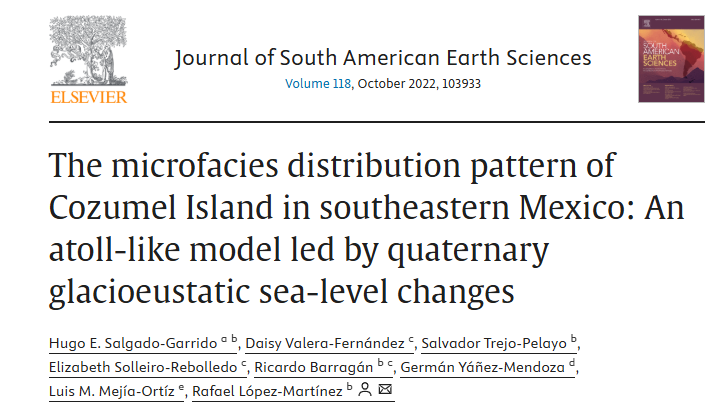The microfacies distribution pattern of Cozumel Island in southeastern Mexico: An atoll-like model led by quaternary glacioeustatic sea-level changes.

Autor
Salgado Garrido, Hugo Enrique
Valera Fernandez, Daisy
Trejo Pelayo, Salvador Antonio
Solleiro Rebolledo, Elizabeth
Barragan Manzo, Ricardo
Yañez Mendoza, German
Mejia Ortiz, Luis Manuel
Lopez Martinez, Rafael
Metadatos
Mostrar el registro completo del ítemResumen
Isolated carbonate banks in stable tectonic settings are ideal for understanding the architecture of sedimentary systems and their response to flooding events. Within these environments, sea-level changes play a primary role in depositing sedimentary units during high sea levels and unconformities during sea-level drops. Microfacies analysis and geologic interpretation, combined with a High Resolution Digital Elevation Model from LiDAR data were used to reevaluate the sediment distribution pattern of Cozumel Island, proposing a new depositional model. The chronostratigraphic framework was established by correlating the exposure surfaces (caliches) of Cozumel with others in adjacent regions. The study of several sections around the island led to the identification of two lithostratigraphic units. Unit 1 comprises two coral reef facies associations (FAs 0 and 1), separated by the Caliche-0 layer. The upper limit of Unit 1 is represented by the Caliche 1 layer and the karst features developed during Marine Isotopic Stage (MIS) 6. Unit 2 was deposited over the ancient karst topography as the lower limit, with Caliche 2 as the upper limit. Unit 2 comprises three facies associations (FAs-2A, B, C), consistent with the protected, open lagoon and the facies of the platform margin, establishing atoll-like depositional conditions. Unit 2 developed during the last interglacial MIS 5e, whereas the Caliche 2 layer started to develop in a post-MIS 5e event during the sea-level drop. This exposed the previous depositional environments to meteoric diagenesis with the formation of the caliche layer. The Caliche 2 layer stabilized the landscape until the present day. Unit 2 correlates to certain morphostratigraphic and geomorphological structures (Terraces I, II, III) on the island. The emplacement of sand islands (FAs-2A), preexisting topography, relative sea-level variations, and sediment supply lead to the pattern and configuration of the depositional model. In addition, the evolution of Cozumel Island during the MIS 5e is similar to other Holocene atoll-like islands in the Caribbean region.
Enlace externo
https://www.sciencedirect.com/science/article/abs/pii/S089598112200222X#preview-section-cited-byColecciones
- Artículos [198]




